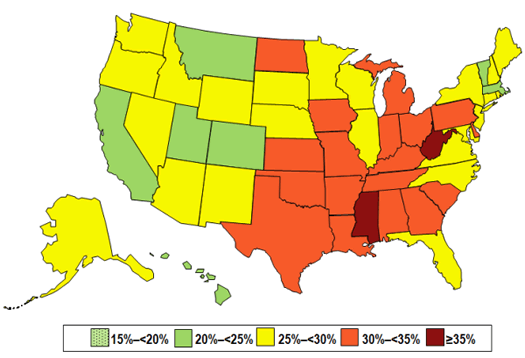New York has one of the country's lowest adult obesity rates, but...

New York's adult obesity rate over the last few decades. From Trust for America's Health and Robert Wood Johnson Foundation. The State of Obesity 2014. (This chart does something it probably shouldn't -- explained below -- but because of most of us here aren't epidemiologists, we'll just over look that for the moment.)
New York was among the states with the lowest percentage of obese adults in 2013, according to figures recently out from the federal Centers for Disease Control and Prevention. The Empire State ranked #42 among the 50 states (and DC) for percentage of obese adults. (Or #10, depending on how you sort the rankings.)
That said, the CDC estimated that a little more than 25 percent of New York adults were obese in 2013, which, from a historical perspective, is not low. That's up from almost 21 percent in 2003, and about 9 percent in 1990.*
The CDC considers adults to be "obese" if their body mass index is 30 or higher. So someone 5 feet 8 inches tall weighing 200 pounds would be considered obese. (And that same person weighing 165 pounds or more would be considered overweight.)
There's a map depicting obesity prevalence rates by state after the jump.
CDC: Prevalence of Self-Reported Obesity Among U.S. Adults by State, BRFSS, 2013

map: Behavioral Risk Factor Surveillance Systems, CDC.
Obesity is an important topic -- it's been linked to a range of health problems, many of which can add up over time to significantly wear on a person. But it's also a complicated topic**, made more so by the fact that it's also often the subject of a lot of (not helpful) moralizing. Back when we covered this sort of thing more frequently, we came to think of overweight and obesity not as end point but a prompt for other questions. Among them:
+ What sorts of communities are people living in?
+ How are those communities physically laid out?
+ Do people have information to make healthy choices?
+ Can they afford those choices?
A handful of socioeconomic factors have been linked to obesity -- especially income and education. So, sure, New York ranks relatively well compared to other states -- but that's not really a surprise because it also ranks relatively well in categories such as median household income (16th) and education levels (#10 for percent of adults with a college degree)***. Though within the state there are wide variations, again probably linked to socioeconomic factors.
Still, there are many more obese (and overweight) adults in the state now compared to a few decades ago. And that prompts a lot interesting, important questions. Chief among them: Why? (Obviously.) And if we we're all a product of our (cultural, social, geographical) environments to some degree, are there ways to shape environments to help people be healthier?
* Here's a look at a bunch of numbers related to obesity in New York State as compiled by the Trust for America's Health and Robert Wood Johnson Foundation as part of their "State of Obesity" report. Its based in part on data from a (famous to health wonks) large telephone survey conducted by the CDC each year -- a survey that CDC changed how it conducted in 2011. So numbers before 2011 and after 2011 shouldn't really be compared (something the CDC mentions).
** One example of how this topic is complicated: There's research that indicates being overweight as you get older could actually decrease your chances of dying.
*** Census Bureau 2010-2012 American Community Survey 3-Year Estimates
Hi there. Comments have been closed for this item. Still have something to say? Contact us.
Comments
And they used BMI. Completely lost my interest.
... said CAOD on Sep 9, 2014 at 7:32 PM | link